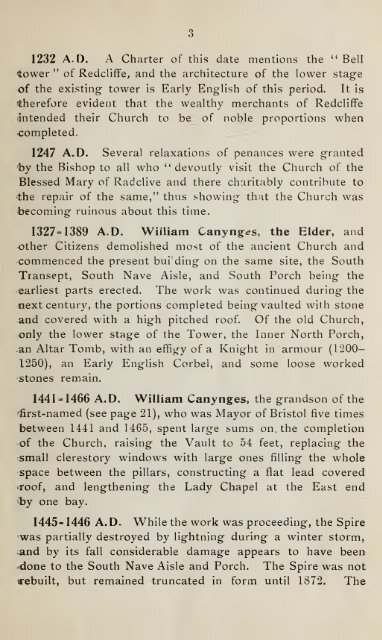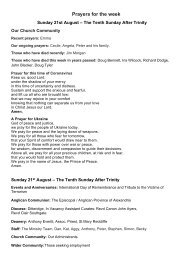A Short Guide to St Mary Redcliffe Bristol Fourth Edition 1921
You also want an ePaper? Increase the reach of your titles
YUMPU automatically turns print PDFs into web optimized ePapers that Google loves.
3<br />
1232 A.D. A Charter of this date mentions the “ Bell<br />
<strong>to</strong>wer ” of <strong>Redcliffe</strong>, and the architecture of the lower stage<br />
of the existing <strong>to</strong>wer is Early English of this period. It is<br />
therefore evident that the wealthy merchants of <strong>Redcliffe</strong><br />
intended their Church <strong>to</strong> be of noble proportions when<br />
completed.<br />
1247 A.D. Se veral relaxations of penances were granted<br />
by the Bishop <strong>to</strong> all who “devoutly visit the Church of the<br />
Blessed <strong>Mary</strong> of Radclive and there charitably contribute <strong>to</strong><br />
•the repair of the same,” thus showing that the Church was<br />
becoming ruinous about this time.<br />
1327=1389 A.D. William Canyngas, the Elder, and<br />
other Citizens demolished most of the ancient Church and<br />
-commenced the present bui’ding on the same site, the South<br />
Transept, South Nave Aisle, and South Porch being the<br />
earliest parts erected. The work was continued during the<br />
next century, the portions completed being vaulted with s<strong>to</strong>ne<br />
and covered with a high pitched roof. Of the old Church,<br />
only the lower stage of the Tower, the Inner North Porch,<br />
.an Altar Tomb, with an effigy of a Knight in armour (1200-<br />
1250), an Early English Corbel, and some loose worked<br />
s<strong>to</strong>nes remain.<br />
1441 = 1466 A.D. William Canynges, the grandson of the<br />
ffirst-named (see page 21), who was Mayor of Bris<strong>to</strong>l five times<br />
between 1441 and 1465, spent large sums on, the completion<br />
-of the Church, raising the Vault <strong>to</strong> 54 feet, replacing the<br />
rsmall cleres<strong>to</strong>ry windows with large ones filling the whole<br />
space between the pillars, constructing a flat lead covered<br />
•roof, and lengthening the Lady Chapel at the East end<br />
by one bay.<br />
1445-1446 A.D. While the work was proceeding, the Spire<br />
was partially destroyed by lightning during a winter s<strong>to</strong>rm,<br />
and by its fall considerable damage appears <strong>to</strong> have been<br />
•done <strong>to</strong> the South Nave Aisle and Porch. The Spire was not<br />
irebuilt, but remained truncated in form until 1872. The


















